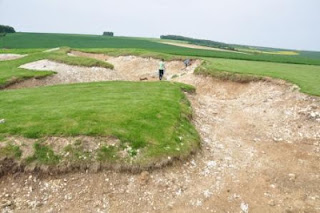Harry enlisted on 11 Jan 15 and by May was at Gallipoli. He received a gun shot wound on 9 May 15 and had to be evacuated. Later, in France, he was hospitalised for frostbite and wounded a further two times. In 1917 he was sent to England and visited relatives. From the descendants of those relatives I have been given permission to reproduce these two photos of Harry.
Harry returned to France on 29 Dec 17 and unfortunately was killed in action on 8 Jul 18, just four months before the end of the war.
As far as I can work out Harry had seven siblings. Some of the sibling died young, never married, had no children or I just can't find any more details.
I managed to follow the family of Harry's sister Isobel Vierk Dixon. Isobel married James Harry Halse. James served during WWII and died in 1982. James and Isobel had two children. It is the family of these children who I will send the medals to.
The medals were found in a rusty tin that was dug up in a Perth back yard by a plumber doing some repair to sewerage pipes. His medal entitlement was the 1914-15 Star, The British War Medal and the Victory Medal. Unfortunately, the original British War Medal has been lost. Many thanks must go to John D who sent the medals to me. After the plumber dug them up they passed through several hands before John put in the effort to look after them and have them remounted.
The returned medal tally is now 1184.


Update 12 Sep 12
After an email from Harry's distant relative, Jim, who kindly provided me with the photos of Harry, I decided to have a look at the 16th Bn war diary. First of all I realised that I had mistakenly listed Harry's date of death as 13 Jul. This was the date the entry was made in Harry's service record and the correct date of KIA was 8 Jul 18. This prompted me to research where Harry was fighting at the time so I had a look at the war diaries.
On 4 Jul the Australian 4th Brigade was involved in the attack on Hamel Wood. On 6 Jul, 16th Bn moved up to the front line trenches that had been captured earlier. On 8 Jul the Germans made a counter attack and it was during this fighting that Harry was killed. The entry states:
'Enemy very busy during day; sniping at the least movement. During the late afternoon a post which was pushed out last night was raided by the enemy. It was first of all dealt with with rifle grenades and pineapple bombs, and an attempt was made to rush it. Several of our fellows were killed and wounded, and two cannot be accounted for. Night was quieter than the previous one. Weather fine and hot. Casualties - 7. Wounded 6.'
In the war diaries only officers were named when they were KIA and other ranks were just listed as a number. I found Harry named in an appendix to the war diary as having been killed in that action.
This link provides a bit more detail about the Battle of Hamel, The photos below were taken at the Hamel Memorial in 2009 by Anna Llanwarne. The first shows the AIF Memorial, the second the village of Hamel from the memorial and the final photo is of the remains of trenches adjucent to the memorial.
Update 25 Sep 12
I have recently been contacted by another relative of Harry Dixon who came across this post. David is Harry's great nephew and he has provided me a newspaper article in which Harry is mentioned. The article appeared in the Western Mail, Thursday 19 October 1939, page 2.








Harry was my uncle. His half brother Alfred Dixon Was killed in in France in 1917 and his mother's cousin was also killed in 1917. Harry's 2 youngest brothers served during WWII in the 2AIF Gerry Dixon rose to the rank of Lt Col while my father John Dixon was captured when Singapore fell and worked in F Force on the Burma Railway.
ReplyDelete